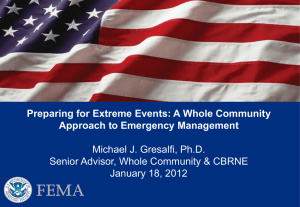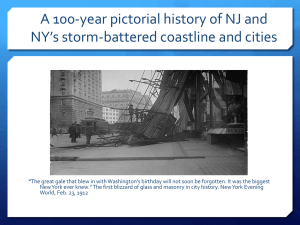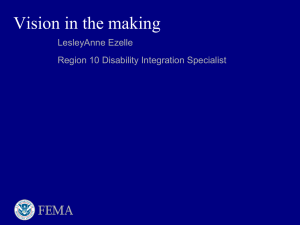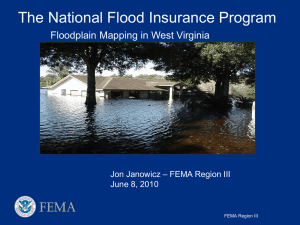Initial Estimate of the Impacts of Hurricane Katrina
advertisement
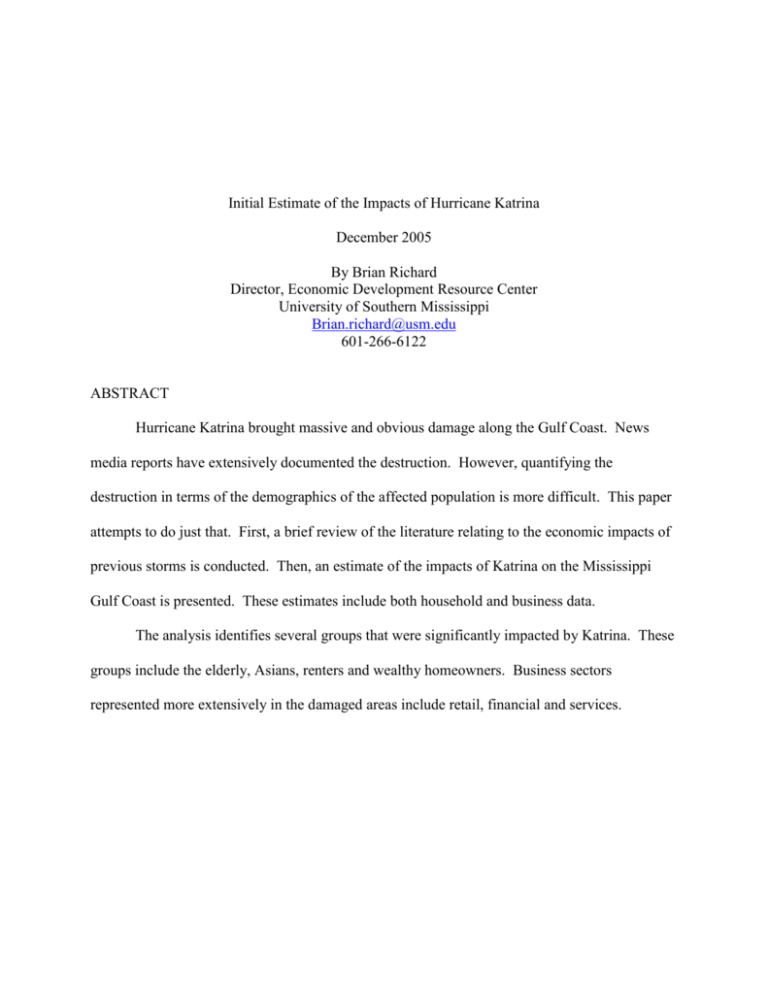
Initial Estimate of the Impacts of Hurricane Katrina December 2005 By Brian Richard Director, Economic Development Resource Center University of Southern Mississippi Brian.richard@usm.edu 601-266-6122 ABSTRACT Hurricane Katrina brought massive and obvious damage along the Gulf Coast. News media reports have extensively documented the destruction. However, quantifying the destruction in terms of the demographics of the affected population is more difficult. This paper attempts to do just that. First, a brief review of the literature relating to the economic impacts of previous storms is conducted. Then, an estimate of the impacts of Katrina on the Mississippi Gulf Coast is presented. These estimates include both household and business data. The analysis identifies several groups that were significantly impacted by Katrina. These groups include the elderly, Asians, renters and wealthy homeowners. Business sectors represented more extensively in the damaged areas include retail, financial and services. August 29, 2005 brought what may turn out to be the costliest natural disaster in United States history. Hurricane Katrina easily surpassed Camille as the hurricane by which all others are compared in south Mississippi. The visual images of the destruction shown on television, newspaper pages and the Internet have documented much of the damage. A more difficult proposition is to systematically measure the household and business damage. What were the demographics of the destruction? How many and what types of businesses were impacted? This paper attempts to answer these questions. IMPACT ESTIMATES OF PREVIOUS EVENTS The most direct way of learning the impacts of a natural disaster is to directly survey those that were impacted. Smith and McCarty (1996) did just that following Hurricane Andrew. Hurricane Andrew was a category 5 hurricane that raked across south Florida in August 1992. Prior to Katrina, it was the costliest disaster in U.S. history. Smith & McCarty conducted a massive (over 5,000 respondents) telephone survey in 1994 to determine the extent of housing damage, along with information about demographic changes in the area. The survey asked respondents about the extent of damage to their homes, insurance settlements, living arrangements of those displaced by the storm, and whether displaced households had yet returned 2 years after the storm. This followed earlier survey work aimed at simply determining the population of the area after Andrew (Smith, 1996). The survey revealed that over half (52 percent) of south Dade county residents were forced to move out of their homes as a result of Andrew (p. 270). Two years later, only about 62 percent of those displaced households had returned to their pre-hurricane residence (p. 271). A significant finding of their research was that households that moved farther away from their prehurricane residence were less likely to return to that original residence. Only 10 percent of south Dade County residents who moved out of Florida following the hurricane returned to their original home. This compares with 72 percent of households that moved to another location within Dade County who returned to their original home (p. 273). Other studies have looked at overall economic impacts of disasters. Chang (1984) found negative overall impacts when analyzing the impacts of Hurricane Frederic on the Alabama Gulf Coast. The study relied on U.S. Army Corps of Engineers estimates of damages and disaster recovery expenditures. Further estimates on the influx of dollars into the area were obtained from various federal sources as well as directly from the private insurers in the area. Chang found that the net impact of Frederic on the Alabama coast was a net loss of almost $600 million. The staff of the South Carolina Budget and Control Board (SCBCB, 1991) estimated the economic losses that resulted from Hurricane Hugo in September 1989. They obtained estimates of gross losses and insurance payments from the S.C. Insurance Commission. Residence destruction and damage assessments were obtained from the Red Cross, based on a damage assessment survey. The Federal Emergency Management Agency (FEMA) provided data on payments made under various programs following the storm. Other emergency payments, such as food stamps, unemployment insurance and crop related payments, were obtained from various State of South Carolina agencies. The study found that damages from Hugo totaled about $6.4 billion, with reimbursements from private and public sources totaling about $3.4 billion, leaving $3 billion in un-reimbursed losses. Guimaraes, Hefner and Woodward (1993) measured the impacts of Hurricane Hugo on the South Carolina economy in the years following the storm. An econometric model was used to project the quarterly track of the South Carolina economy as if Hugo had never occurred. They then compared the quarterly estimates with observed data over a 2 ½ year period following the hurricane. The study found significant positive income effects in several sectors of the economy, most notably the construction sector. However, overall positive income effects were significantly lower than the loss of wealth computed by SCBCB and reported again in this study. West and Lenze (1994) also use an econometric modeling approach in the analysis of Hurricane Andrew. They used data from Property Claim Services (insurance claims), Red Cross surveys, utility companies, and government agency reports to estimate total physical damages resulting from the storm. These data were then used to estimate reconstruction expenditures in several sectors: structure replacement, repair services, and new purchases. Expenditure estimates in the various sectors were used as inputs into a Florida econometric model. As with the results from Hurricane Hugo in South Carolina, the biggest impacts on the Florida economy occurred in the construction sector. Both income and employment were estimated to be significantly higher for 2 to 3 years following Andrew. Increased income was also estimated in the services and trade sectors over this period. The longer term (the study looked at the period 1992 to 2005) impacts showed a net negative impact of the storm. Job losses were estimated at about 12,000, mostly as a result of the closing of Homestead Air Force Base and the permanent relocation of a portion of the South Florida population. The temporary increases in income due to post-storm rebuilding were not enough to offset the massive loss of wealth that occurred as a result of storm damage. HURRICANE KATRINA IMPACTS One common aspect of all of the analyses presented above is that they were conducted two to three years after the storms. While this allows for more complete sources of data, there is certainly value in more contemporary estimates. Here a more indirect method will be used to provide estimates of damages just weeks after the storm. One of the important sources of data for many of the studies described above, the Federal Emergency Management Agency (FEMA), also provides important data for this study. In the days after the Katrina made landfall, FEMA provided a series of GIS map layers outlining areas on the Gulf Coast that were impacted at various levels. “Soon after the disaster event, FEMA managers and staff use GIS to visualize actual damages by analyzing collected aerial reconnaissance and ground truth data. Using GIS, MAC customers (i.e. Disaster Field Office (DFO), Emergency Support Team (EST) personnel, etc.) can see the spatial extent of damage, learn who was affected by the disaster and which resources were affected (FEMA, 2004).” Map 1 displays the FEMA estimates of various damage levels on the Mississippi Gulf Coast1. News reports often describe the railroad tracks as a barrier to the storm surge and thus, a dividing line between devastation and less severe damage. This is reflected in the FEMA data. The red strip (representing ‘catastrophic’ damage) that runs along the coast is bounded, with few exceptions, by the railroad tracks to the north. The total area of all five FEMA damage areas is about 140 square miles. The area of the two most extensive damage areas totals about 28 square miles. 1 Definition of FEMA damage categories: Catastrophic Damage: Most solid and all light or mobile structures are destroyed. Extensive Damage: Some solid structures are destroyed; most sustain exterior and interior damage (e.g., roofs are missing, interior walls exposed), most mobile homes and light structures are destroyed. Moderate Damage: Solid structures sustain exterior damage (e.g., missing roofs or roof segments); some mobile homes and light structures are destroyed, many are damaged or displaced. Limited Damage: Generally superficial damage to solid structures (e.g., loss of tiles or roof shingles); some mobile homes and light structures are damaged or displaced. Flood Damage: Indicates a separate severe damage category related to the specific effects of flooding. Map 1. FEMA Damage Assessments. FEMA Damage Categories CAT AST ROPHIC EXT ENSIVE MODERAT E LIMIT ED FLOOD Based on the areas delineated by the FEMA maps, we can estimate the number of households and businesses that were impacted by Katrina. Data estimates were obtained using a GIS based data analysis tool called PCensus. Census 2000 and Claritas 2005 demographic and business data at the Census block level were aggregated based on the areas outlined by each FEMA damage category. Household Impacts Table 1 displays some basic statistics about the households impacted by Hurricane Katrina. Over 37,000 persons lived in the ‘catastrophic’ damage assessment areas, representing about 10 percent of the total population of Hancock, Harrison and Jackson counties. About 37 percent of the total Mississippi Gulf Coast population lived somewhere in one of the five FEMA damage areas. Table 1. Estimated Population in FEMA Damage Areas. Population 370,396 Households 140,103 37,336 10.1% 16,676 11.9% Extensive 6,416 1.7% 2,140 1.5% Moderate 13,935 3.8% 5,418 3.9% Limited 74,282 20.1% 27,075 19.3% Flood 5,719 1.5% 2,439 1.7% Total 137,688 37.2% 53,748 38.4% 3 County Total Catastrophic Percentages represent the portion of each category that falls in the corresponding FEMA category. More extensive demographic data is presented in Appendix 1. Hurricane Katrina impacted a higher proportion of older persons than the population as a whole. One in five people over 85 lived in the catastrophic zone. This compares with one person out of ten in the overall population in that zone. Looking at the race statistics, the Asian population was hit significantly harder than the population as a whole. Almost ¼ of all Asian people on the coast lived in the catastrophic damage zone. Black persons were less likely to be in the most heavily damaged areas but are over represented in the limited damage zone. The housing data reveals that persons either on the low end or the upper end of the income spectrum were more likely to have been severely impacted by the storm. Housing units in the catastrophic damage area were twice as likely to have been renter occupied as opposed to owner occupied. One in five renter occupied housing units were either in the catastrophic or extensive damage areas. Lower income households were more likely to be in the seriously damaged areas. This may reflect a couple of the trends mentioned above. Both elderly persons and renters tend to have lower annual incomes than the overall population. Not surprisingly, because of the damage along the beachfront, expensive homes were hammered by the storm. Over one quarter of all owner occupied homes valued over $400,000 in the three county area were in the catastrophic damage zone. This is also reflected in the income data which shows that households with annual incomes over $150,000 were more likely to be in the catastrophic zone. Mississippi Governor Haley Barbour has stated that FEMA will provide about 34,000 mobile homes and travel trailers throughout the state (Cogswell, 2005). From Table 1, we see that over three quarters of that number, about 27,000 households, were located in the catastrophic, extensive, moderate, and flood damage zones from the FEMA maps. Based on the data we have, the 27,000 figure may be a good estimate of unlivable housing at this point, less than three months after the storm. Business Impacts Two out of every five businesses on the Gulf Coast were located in one of the FEMA damage zones (Table 2). Over 15 percent of the businesses were in the most heavily damaged zone. The firms in the catastrophic zone provided over 20 percent of all jobs in the three counties. Table 2. Estimated Business Population in FEMA Damage Areas. Establishments 14,099 Employment 180,428 Total Sales (millions) $16,937 2,152 15.3% 37,853 21.0% $2,979 17.6% Extensive 218 1.5% 2,465 1.4% $225 1.3% Moderate 682 4.8% 6,825 3.8% $642 3.8% 2,286 16.2% 22,157 12.3% $2,087 12.3% Flood 166 1.2% 1,542 0.9% $183 1.1% Total 5,504 39.0% 70,842 39.3% $6,116 36.1% 3 Coast Counties Catastrophic Limited Percentages represent the portion of each category that falls in the corresponding FEMA category. Appendix 2 shows the sectoral breakdown of the businesses in the FEMA damage categories. Over one quarter of all jobs in the retail, financial, and service industries were in the catastrophic damage area. Over 86 percent of the jobs in the catastrophic zone were in those three sectors. Manufacturing was largely spared the destruction. Only about 10 percent of total manufacturing employment in the three coast counties was in any of the FEMA damage zones. Mississippi State Tax Commission data reflects the destruction in the retail sector. Table 3 shows retail sales tax collections from cities in the three coastal counties (MSTC, 2005). Five cities, Waveland, Pass Christian, Bay St. Louis, Biloxi, and Long Beach had lower retail sales in October 2005 relative to 2004. These cities all had significant portions of their retail sectors located in the catastrophic damage zone, as displayed in Map 1. Gulfport was aided by having a large portion of its retail sector located farther inland. However, Gulfport still just matched the statewide retail growth despite having retail sectors in the surrounding cities virtually wiped out. Cities with more protected retail sectors, notably Gautier, D’Iberville, and Pascagoula saw very large increases in retail sales. Also, cities in the counties directly north of the coastal counties saw large increases in retail sales. Wiggins, 30 miles north of Gulfport on Highway 49 saw a 70 percent increase in retail sales over the previous year. Table 3. Diversion to Cities from Sales Tax Collections. City Waveland Pass Christian Bay St. Louis Biloxi Long Beach Moss Point Gulfport Ocean Springs Gautier D'Iberville Pascagoula Totals Oct 2005 $ 25,553 $ 21,651 $ 60,402 $ 692,606 $ 99,528 $ 131,845 $ 1,593,290 $ 375,901 $ 242,913 $ 431,335 $ 716,239 $ 4,391,262 Oct 2004 $ 175,080 $ 96,161 $ 100,131 $ 1,005,454 $ 118,771 $ 120,523 $ 1,385,744 $ 291,529 $ 166,974 $ 281,184 $ 440,036 $ 4,181,585 Change -85% -77% -40% -31% -16% 9% 15% 29% 45% 53% 63% 5% Mississippi $ 31,993,514 $ 28,127,180 14% SUMMARY This analysis describes some of the populations impacted by Hurricane Katrina. In many cases these populations differ significantly from the overall Mississippi Gulf Coast population. Groups more likely to live in the catastrophic damage zone include Asians, wealthy homeowners, and persons living in rental housing. In the business sector, retail, finance and services were damaged significantly. Going forward, this data will be used as a basis for estimating the value of the destruction brought by Hurricane Katrina in Mississippi. The data can then be compared to the damage estimates in previous disasters. An estimate of the value of destruction from Katrina compared with the experiences from previous disasters will allow us to make predictions regarding economic activity during the recovery. REFERENCES Chang, Semoon. (1984). Do Disaster Areas Benefit from Disasters? Growth and Change, 15: 2431. Cogswell, Joshua. (2005, November 22). FEMA extends hotel aid 2 weeks. The Clarion-Ledger. Retrieved November 22, 2005, from www.clarionledger.com. Federal Emergency Management Agency Mapping and Analysis Center. (2004). How FEMA Used GIS in Disaster Response. [electronic version]. Retrieved November 14, 2005, from http://www.gismaps.fema.gov/gis04.shtm. Federal Emergency Management Agency Mapping and Analysis Center. (2005). Hurricane Katrina Remote Sensing Data, September 19, 1000. Retrieved September 29, 2005, from http://www.gismaps.fema.gov/2005pages/rsdrkatrina.shtm . Guimaraes, Paulo, Frank L. Hefner, and Douglas P. Woodward. (1993). Wealth and Income Effects of Natural Disasters: and Econometric Analysis of Hurricane Hugo. Review of Regional Studies. 23: 39-53. Mississippi State Tax Commission. (2005). Diversions to Cities from Sales Tax Collections, October 2005. Retrieved November 22, 2005, from http://www.mstc.state.ms.us/info/stats/divers.htm. Smith, Stanley K. (1996). Demography of Disaster: Population Estimates after Hurricane Andrew. Population Research and Policy Review. 15(5-6): 459-477. Smith, Stanley K. and Christopher McCarty. (1996). Demographic Effects of Natural Disasters: A Case Study of Hurricane Andrew. Demography. 33(2): 265-275. South Carolina Budget and Control Board. Division of Research and Statistical Services, Office of Economic Research. (1991). “Economic Impact of Hurricane Hugo.” Columbia, S.C. West, Carol T. and David G. Lenze. (1994). Modeling the Regional Impact of Natural Disaster and Recovery: a General Framework and an Application to Hurricane Andrew. International Regional Science Review. 17(2): 121-150. Appendix 1. Estimated Household Data by FEMA Damage Categories. 3 County Total Total Population Total Households Growth 2005-2010 Growth 2000-2005 Growth 1990 - 2000 Daytime Population 2005 Estimated Total Population by Age Age 16 and over Age 18 and over Age 21 and over Age 65 and over Age 85 and over 370,396 140,103 1.85% 1.76% 21.71% 181,383 Percentages represent the portion of each category that falls in the corresponding FEMA category Catastrophic Extensive Moderate Limited Flood Total % % % % % % 37,336 10.1% 6,416 1.7% 13,935 3.8% 74,282 20.1% 5,719 1.5% 137,688 37.2% 16,676 11.9% 2,140 1.5% 5,418 3.9% 27,075 19.3% 2,439 1.7% 53,748 38.4% -2.20% 2.2% 1.8% 1.1% 3.3% -2.75% 2.9% 1.2% 1.2% 1.8% 12.40% 24.8% 19.0% 18.6% 51.7% 37,991 20.9% 2,489 1.4% 6,914 3.8% 22,554 12.4% 1,597 0.9% 71,545 39.4% 286,271 275,580 258,738 44,441 4,254 30,322 29,541 28,222 6,423 866 35.64 36.46 39.39 40.25 2005 Estimated Population by Race White Alone Black or African American Alone Asian Alone 273,529 76,590 8,758 28,073 5,893 1,976 10.3% 7.7% 22.6% 6,416 5,118 1.9% 979 1.3% 87 1.0% 2005 Tenure of Occupied Housing Units Owner Occupied Renter Occupied 140,103 97,830 42,273 8,898 7,778 9.1% 18.4% 2,140 1,495 1.5% 645 1.5% 2005 Estimated Average Household Income 2005 Estimated Median Household Income 2005 Estimated Per Capita Income $53,276 $42,075 $20,550 $52,170 $38,019 $23,645 $49,737 $35,995 $19,177 $52,103 $39,815 $20,562 $51,865 $40,848 $19,872 $43,961 $34,268 $18,759 2.57 2.2 2.46 2.44 2.57 2.44 2005 Estimated Median Age 2005 Estimated Average Age 2005 Average Household Size 10.6% 10.7% 10.9% 14.5% 20.4% 5,183 5,013 4,554 773 100 1.8% 1.8% 1.8% 1.7% 2.4% 32.67 35.93 10,940 10,524 9,949 1,995 245 3.8% 3.8% 3.8% 4.5% 5.8% 37.43 38.16 20.2% 20.3% 19.7% 19.9% 20.7% 34 35.85 13,935 10,833 4.0% 2,583 3.4% 201 2.3% 5,418 3,693 1,725 57,902 55,815 50,924 8,835 881 3.8% 4.1% 4,606 4,442 4,225 702 37 1.6% 1.6% 1.6% 1.6% 0.9% 108,953 105,335 97,874 18,728 2,129 38.1% 38.2% 37.8% 42.1% 50.0% 39.52 38.79 74,282 49,530 18.1% 20,555 26.8% 1,592 18.2% 5,719 100,352 5,319 1.9% 98,873 36.1% 177 0.2% 30,187 39.4% 43 0.5% 3,899 44.5% 27,075 17,991 18.4% 9,084 21.5% 2,439 37,072 1,983 2.0% 34,060 34.8% 456 1.1% 19,688 46.6% 3 County Total Owner-Occupied Housing Value (2000 Census) Less than $20,000 $20,000 to $39,999 $40,000 to $59,999 $60,000 to $79,999 $80,000 to $99,999 $100,000 to $149,999 $150,000 to $199,999 $200,000 to $299,999 $300,000 to $399,999 $400,000 to $499,999 $500,000 to $749,999 $750,000 to $999,999 $1,000,000 or more 93,850 4,462 8,976 15,152 18,833 15,714 17,394 6,940 4,001 1,160 533 304 107 274 Catastrophic % 9,041 193 4.3% 618 6.9% 1,438 9.5% 1,676 8.9% 1,504 9.6% 1,745 10.0% 866 12.5% 506 12.6% 184 15.9% 144 27.0% 78 25.7% 31 29.0% 58 21.2% Extensive % 1,415 124 2.8% 191 2.1% 280 1.8% 180 1.0% 195 1.2% 248 1.4% 86 1.2% 72 1.8% 22 1.9% 9 1.7% 8 2.6% 1 0.9% 0 0.0% Moderate % 3,548 138 3.1% 202 2.3% 577 3.8% 723 3.8% 641 4.1% 829 4.8% 228 3.3% 145 3.6% 24 2.1% 30 5.6% 8 2.6% 1 0.9% 3 1.1% Limited % 17,345 624 14.0% 1,398 15.6% 2,949 19.5% 3,738 19.8% 3,090 19.7% 3,271 18.8% 1,159 16.7% 717 17.9% 254 21.9% 62 11.6% 44 14.5% 10 9.3% 27 9.9% Flood 1,905 170 380 341 313 286 269 76 36 24 6 1 1 1 Total % % 3.8% 4.2% 2.3% 1.7% 1.8% 1.5% 1.1% 0.9% 2.1% 1.1% 0.3% 0.9% 0.4% 33,254 1,249 2,789 5,585 6,630 5,716 6,362 2,415 1,476 508 251 139 44 89 28.0% 31.1% 36.9% 35.2% 36.4% 36.6% 34.8% 36.9% 43.8% 47.1% 45.7% 41.1% 32.5% 2005 Estimated Households by Household Income Less than $15,000 $15,000 to $24,999 $25,000 to $34,999 $35,000 to $49,999 $50,000 to $74,999 $75,000 to $99,999 $100,000 to $149,999 $150,000 to $249,999 $250,000 to $499,999 $500,000 or more 140,103 22,161 17,248 18,599 25,535 27,607 14,044 10,592 3,027 1,009 281 16,676 2,825 2,459 2,447 3,012 2,826 1,312 1,148 424 179 42 12.7% 14.3% 13.2% 11.8% 10.2% 9.3% 10.8% 14.0% 17.7% 14.9% 2,140 429 310 306 365 334 168 148 60 15 4 1.9% 1.8% 1.6% 1.4% 1.2% 1.2% 1.4% 2.0% 1.5% 1.4% 5,418 1,031 675 680 1,006 1,039 465 347 89 71 16 4.7% 3.9% 3.7% 3.9% 3.8% 3.3% 3.3% 2.9% 7.0% 5.7% 27,075 4,523 3,447 3,632 4,966 5,161 2,576 1,980 569 167 54 20.4% 20.0% 19.5% 19.4% 18.7% 18.3% 18.7% 18.8% 16.6% 19.2% 2,439 499 369 380 387 453 167 162 14 8 1 2.3% 2.1% 2.0% 1.5% 1.6% 1.2% 1.5% 0.5% 0.8% 0.4% 53,748 9,307 7,260 7,445 9,736 9,813 4,688 3,785 1,156 440 117 42.0% 42.1% 40.0% 38.1% 35.5% 33.4% 35.7% 38.2% 43.6% 41.6% 2005 Est. Population by Educational Attainment Less than 9th grade Some High School, no diploma High School Graduate (or GED) Some College, no degree Associate Degree Bachelor's Degree Master's Degree Professional School Degree Doctorate Degree 237,401 13,961 32,822 70,956 60,089 17,988 26,657 10,124 3,569 1,235 26,270 1,642 3,087 6,993 7,064 1,711 3,590 1,404 597 183 11.8% 9.4% 9.9% 11.8% 9.5% 13.5% 13.9% 16.7% 14.8% 3,855 273 694 1,120 907 223 402 133 84 18 2.0% 2.1% 1.6% 1.5% 1.2% 1.5% 1.3% 2.4% 1.5% 9,164 634 1,374 2,673 2,174 551 1,044 478 191 46 4.5% 4.2% 3.8% 3.6% 3.1% 3.9% 4.7% 5.4% 3.7% 45,851 2,658 6,232 13,132 11,651 3,511 5,496 2,165 649 356 19.0% 19.0% 18.5% 19.4% 19.5% 20.6% 21.4% 18.2% 28.8% 3,930 362 678 1,153 1,059 230 279 121 42 5 2.6% 2.1% 1.6% 1.8% 1.3% 1.0% 1.2% 1.2% 0.4% 89,070 5,569 12,065 25,071 22,855 6,226 10,811 4,301 1,563 608 39.9% 36.8% 35.3% 38.0% 34.6% 40.6% 42.5% 43.8% 49.2% Appendix 2. Estimated Business Data by FEMA Damage Categories. Percentages represent the portion of each category that falls in the corresponding FEMA category Catastrophic Extensive Moderate Limited Flood Total % % % % % % 2,152 15.3% 218 1.5% 682 4.8% 2,286 16.2% 166 1.2% 5,504 39.0% 14 5.6% 2 0.8% 9 3.6% 35 14.0% 3 1.2% 63 25.2% 69 6.6% 9 0.9% 38 3.6% 131 12.5% 11 1.1% 258 24.7% 62 11.8% 9 1.7% 17 3.2% 62 11.8% 7 1.3% 157 30.0% 82 13.2% 9 1.5% 25 4.0% 90 14.5% 12 1.9% 218 35.2% 54 10.1% 8 1.5% 18 3.4% 74 13.8% 7 1.3% 161 30.0% 531 16.6% 57 1.8% 185 5.8% 483 15.1% 53 1.7% 1,309 40.9% 264 17.7% 21 1.4% 79 5.3% 256 17.2% 12 0.8% 632 42.5% 904 15.9% 86 1.5% 263 4.6% 1,000 17.6% 53 0.9% 2,306 40.7% 172 22.4% 17 2.2% 48 6.3% 155 20.2% 8 1.0% 400 52.2% Establishments Agriculture & Natural Resources Construction Manufacturing Transportation, Utilities Wholesale Trade Retail Trade Finance, Insurance, Real Estate Services Government 3 Coast Counties Totals 14,099 250 1,045 524 619 537 3,197 1,488 5,672 767 Employment Agriculture & Natural Resources Construction Manufacturing Transportation, Utilities Wholesale Trade Retail Trade Finance, Insurance, Real Estate Services Government 180,428 1,153 9,527 20,335 6,951 5,919 42,016 8,750 71,264 14,513 37,853 48 390 910 845 429 10,984 2,221 19,613 2,461 21.0% 4.2% 4.1% 4.5% 12.2% 7.2% 26.1% 25.4% 27.5% 17.0% 2,465 7 118 183 80 63 487 108 1,160 266 1.4% 0.6% 1.2% 0.9% 1.2% 1.1% 1.2% 1.2% 1.6% 1.8% 6,825 39 242 238 317 124 1,620 416 3,138 730 3.8% 22,157 12.3% 3.4% 191 16.6% 2.5% 988 10.4% 1.2% 737 3.6% 4.6% 1,056 15.2% 2.1% 595 10.1% 3.9% 4,000 9.5% 4.8% 1,352 15.5% 4.4% 10,781 15.1% 5.0% 2,648 18.2% 1,542 11 76 30 89 34 706 63 456 88 0.9% 70,842 39.3% 1.0% 296 25.7% 0.8% 1,814 19.0% 0.1% 2,098 10.3% 1.3% 2,387 34.3% 0.6% 1,245 21.0% 1.7% 17,797 42.4% 0.7% 4,160 47.5% 0.6% 35,148 49.3% 0.6% 6,193 42.7% Total Sales (millions) Agriculture & Natural Resources Construction Manufacturing Transportation, Utilities Wholesale Trade Retail Trade Finance, Insurance, Real Estate Services Government 16,937 $53 $1,721 $1,610 $681 $1,161 $4,488 $1,799 $5,424 $0 $2,979 $2 $73 $83 $86 $77 $827 $469 $1,364 $0 17.6% 3.8% 4.2% 5.2% 12.6% 6.6% 18.4% 26.1% 25.1% $225 $0 $21 $14 $8 $11 $70 $24 $77 $0 1.3% 0.0% 1.2% 0.9% 1.2% 0.9% 1.6% 1.3% 1.4% $642 $2 $46 $20 $32 $23 $211 $82 $228 $0 3.8% $2,087 12.3% 3.8% $8 15.1% 2.7% $187 10.9% 1.2% $66 4.1% 4.7% $106 15.6% 2.0% $106 9.1% 4.7% $498 11.1% 4.6% $279 15.5% 4.2% $845 15.6% $0 $183 $1 $14 $3 $8 $6 $109 $11 $32 $0 1.1% $6,116 36.1% 1.9% $13 24.5% 0.8% $341 19.8% 0.2% $186 11.6% 1.2% $240 35.2% 0.5% $223 19.2% 2.4% $1,715 38.2% 0.6% $865 48.1% 0.6% $2,546 46.9% $0
